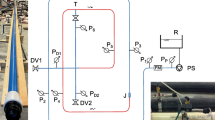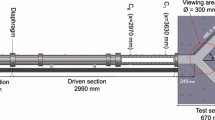Abstract.
The propagation of a planar shock wave in a 90° branched duct is studied experimentally and numerically. It is shown that the interaction of the transmitted shock wave with the branching segment results in a complex, two-dimensional unsteady flow. Multiple shock wave reflections from the duct's walls cause weakening of transmitted waves and, at late times, an approach to an equilibrium, one-dimensional flow. While at most places along the branched duct walls calculated pressures are lower than that existing behind the original incident shock wave, at the branching segment's right corner, where a head on-collision between the transmitted wave and the corner is experienced, pressures that are significantly higher than those existing behind the original incident shock wave are encountered. The numerically evaluated pressures can be accepted with confidence, due to the very good agreement found between experimental and numerical results with respect to the geometry of the complex wave pattern observed inside the branched duct.
Similar content being viewed by others
Author information
Authors and Affiliations
Additional information
Received 15 July 1996 / Accepted 20 February 1997
Rights and permissions
About this article
Cite this article
Igra, O., Wang, L., Falcovitz, J. et al. Shock wave propagation in a branched duct. Shock Waves 8, 375–381 (1998). https://doi.org/10.1007/s001930050130
Issue Date:
DOI: https://doi.org/10.1007/s001930050130




